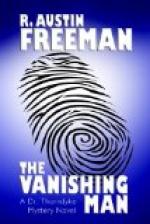“It is very natural,” he said at length, “that you should associate these remains with the mystery of your brother’s disappearance. I should like to say that you are wrong in doing so, but if I did I should be uncandid. There are certain facts that do, undoubtedly, seem to suggest a connection, and, up to the present, there are no definite facts of a contrary significance.”
Mr. Bellingham sighed deeply and shifted uncomfortably in his chair.
“It is a horrible affair!” he said huskily; “horrible! Would you mind, Doctor Thorndyke, telling us just how the matter stands in your opinion—what the probabilities are, for and against?”
Again Thorndyke reflected awhile, and it seemed to me that he was not very willing to discuss the subject. However, the question had been asked pointedly, and eventually he answered:
“At the present stage of the investigation it is not very easy to state the balance of probabilities. The matter is still quite speculative. The bones which have been found hitherto (for we are dealing with a skeleton, not with a body) have been exclusively those which are useless for personal identification; which is, in itself, a rather curious and striking fact. The general character and dimensions of the bones seem to suggest a middle-aged man of about your brother’s height, and the date of deposition appears to be in agreement with the date of his disappearance.”
“Is it known, then, when they were deposited?” Mr. Bellingham asked.
“In the case of those found at Sidcup it seems possible to deduce an approximate date. The watercress-bed was cleaned out about two years ago, so they could not have been lying there longer than that; and their condition suggests that they could not have been there much less than two years, as there is apparently not a vestige of the soft structures left. Of course, I am speaking from the newspaper reports only; I have no direct knowledge of the matter.”
“Have they found any considerable part of the body yet? I haven’t been reading the papers myself. My little friend, Miss Oman, brought a great bundle of ’em for me to read, but I couldn’t stand it; I pitched the whole boiling of ’em out of the window.”
I thought I detected a slight twinkle in Thorndyke’s eye, but he answered quite gravely:
“I think I can give you the particulars from memory, though I won’t guarantee the dates. The original discovery was made, apparently quite accidentally, at Sidcup on the fifteenth of July. It consisted of a complete left arm, minus the third finger and including the bones of the shoulder—the shoulder-blade and collar-bone. This discovery seems to have set the local population, especially the juvenile part of it, searching all the ponds and streams of the neighbourhood—”
“Cannibals!” interjected Mr. Bellingham.




